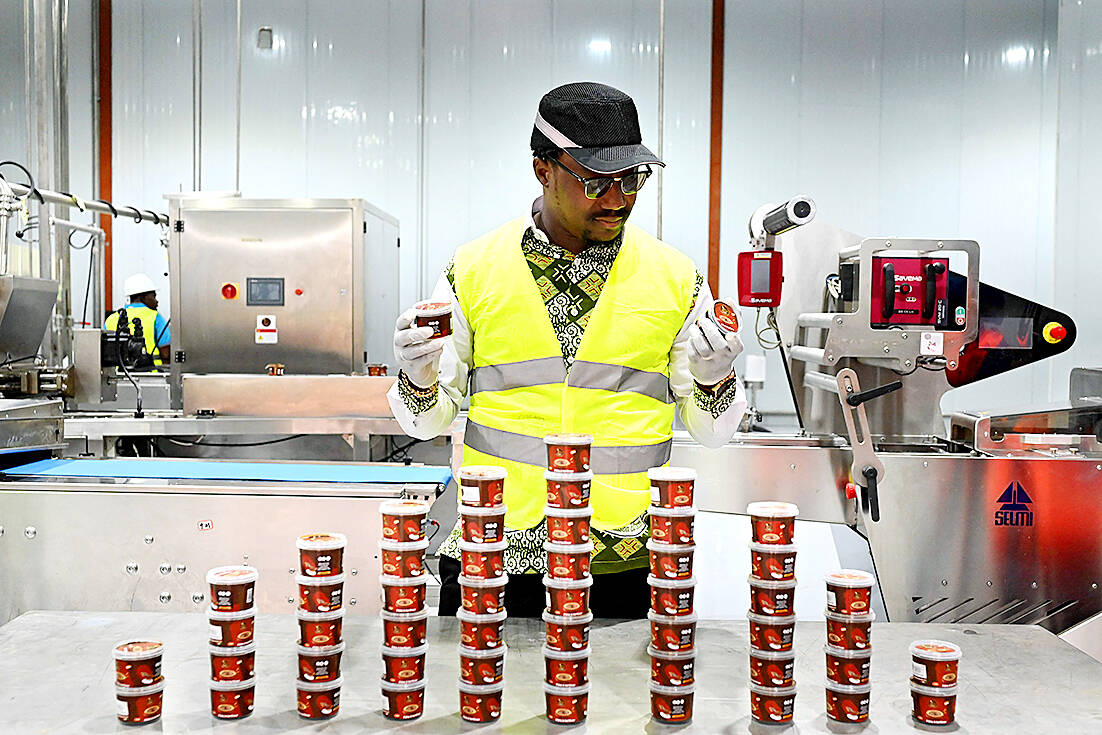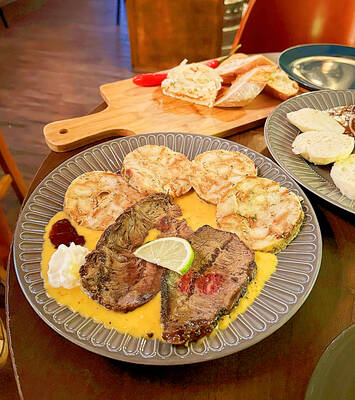Would you eat lab-grown chocolate?
I requested a sample from California Cultured, a Sacramento-based company. Its chocolate, not yet commercially available, is made with techniques that have previously been used to synthesize other bioactive products like certain plant-derived pharmaceuticals for commercial sale.
A few days later, it arrives. The morsel, barely bigger than a coffee bean, is supposed to be the flavor equivalent of a 70 percent to 80 percent dark chocolate. I tear open its sealed packet and a chocolatey aroma escapes — so far, so good. I pop it in my mouth.

Photo: AFP
Slightly waxy and distinctly bitter, it boasts those bright, fruity dark chocolate notes. I’m no expert, but I enjoyed it — and found it basically indistinguishable from regular dark chocolate.
Globally, humans consume more than 7 million metric tons of chocolate per year, and our appetite is only growing. In the US, chocolate demand surges in October in advance of Halloween; the National Retail Federation estimated a US$3.9 billion spend on Halloween candy this year, with chocolate options like Reese’s Peanut Butter Cups and M&Ms dominating.
VOLATILE MARKET

Photo: AFP
But the chocolate market has grown volatile in recent years. Cacao trees — which provide chocolate’s essential ingredient — are particularly vulnerable to drought and disease. Additionally, unpredictable weather related to the climate crisis has caused production shortfalls and inconsistent harvests in key chocolate-producing regions in west Africa.
Chocolate prices reached a historic high of US$12,000 per metric ton last year, though the rising costs have not truly deterred consumers, explains Bloomberg Intelligence market analyst Ignacio Canals Polo.
Big confectionery companies like Mondelez, Mars and Nestle are most heavily affected by price hikes. Canals Polo says they are “trying to adjust their portfolios to rely less on cocoa” by “shrinkflating” their products; reformulating recipes to use cheaper ingredients, such as vegetable oil instead of cocoa butter; and promoting non-chocolate confections, like biscuits, gummy candy or chocolate-free spins on classic products — think KitKats enrobed in flavored cream coatings.

Photo: AFP
This volatility represents an opportunity for the lab-grown product. California Cultured takes cuttings from regular cacao plants and cultivates the cells on plates containing a nutrient-rich medium made mostly of sugar and plant extracts. The company then grows specific cell types, such as those that produce cocoa butter or cocoa flavanols, says Alan Perlstein, the company’s CEO. After that comes harvesting, fermenting, drying, milling and packaging the product into, functionally, a lab-grown cocoa powder to be used in confections like bars and drinks.
Other companies, such as Nukoko and ChoViva, are developing chocolate alternatives made from ingredients including fermented fava beans or sunflower seeds. Scientists are experimenting with chocolate made from ground cacao husks typically discarded in the conventional chocolate-making process.
California Cultured is still waiting on Food and Drug Administration approval to launch its chocolate to market. But it has established its first commercial partnership with the Japanese confectionery company Meiji, which makes Hello Panda and Chocorooms. Perlstein says California Cultured’s processes can facilitate “more interesting flavors, aromas or experiences.”
Initially, lab-grown chocolate may be more expensive, but Perlstein hopes the price difference will disappear within three years of becoming available. If scaling these processes up is feasible, Americans could be seeing chocolate products with a “lab-grown” designation on shelves as soon as next Halloween. But will people buy them?
NEOPHOBIA
“I think in certain niche sectors, like tech, it’s going to be very, very cool to be like, ‘It’s lab-grown chocolate — you can have more control, you can geek out on the very fine nuances,’” says Eagranie Yuh, a former chocolatier and chocolate educator.
But Yuh also thinks “most people have a visceral response” to the idea of lab-grown food. A 2023 German survey of 727 people found that food-technology neophobia — a fear of the new — strongly influenced attitudes about lab-grown meat, though even the wary were at least willing to try it.
Emphasizing adjustments to chocolate, such as tweaked levels of caffeine and health-supporting polyphenols, also adds “a rational element to what is a largely an emotionally driven product,” Yuh says. “Chocolate is very human.”
For instance, we commonly prefer the tasty but lower-quality bars of our youth. Yuh says the human narrative behind products can also be important for chocolate consumers, such as knowing that ingredients were responsibly grown and processed by people who were fairly paid.
It’s unclear how consumers will react to lab-grown products or when they will become available. But chocolate lovers will probably face questions of cost — financial, ecological and ethical.
There could be ecological benefits to lab-grown chocolate. Cacao trees are often farmed on deforested land, degrading soil and requiring heavy doses of fertilizer and pesticides. But “the socioeconomic consequences of rolling out [lab-grown chocolate] at large scale could be huge for the smallholder farmers in West Africa,” who rely on cacao sales for their livelihood, says Sophia Carodenuto, a political geographer specializing in global food systems at the University of Victoria.
“Lab-grown chocolate may be innovative, but it can’t replace the heritage, livelihoods and soul behind real cocoa,” says Shirley Temeng-Asomaning, founder and CEO of Chocolate Mall, a Ghana-based confectionery company. “My hope is that science will complement and not compete with the farmers who built this industry, and that technology helps make chocolate more sustainable, not less human.”
For his part, Perlstein believes the demand for chocolate is “infinite” — and big enough to support new players.
“The demands of cocoa are just so ravenous — even if every single cocoa farmer were to expand production constantly year after year, which would be impossible, there would still be a huge demand,” he says, citing the growth of newer chocolate-consuming markets such as China, India and Africa.
Demand may exist, Carodenuto says, but “what is needed is for the market to pay more for ethical and ecologically sustainable cocoa.”

Seven hundred job applications. One interview. Marco Mascaro arrived in Taiwan last year with a PhD in engineering physics and years of experience at a European research center. He thought his Gold Card would guarantee him a foothold in Taiwan’s job market. “It’s marketed as if Taiwan really needs you,” the 33-year-old Italian says. “The reality is that companies here don’t really need us.” The Employment Gold Card was designed to fix Taiwan’s labor shortage by offering foreign professionals a combined resident visa and open work permit valid for three years. But for many, like Mascaro, the welcome mat ends at the door. A

The Western media once again enthusiastically forwarded Beijing’s talking points on Japanese Prime Minister Sanae Takaichi’s comment two weeks ago that an attack by the People’s Republic of China (PRC) on Taiwan was an existential threat to Japan and would trigger Japanese military intervention in defense of Taiwan. The predictable reach for clickbait meant that a string of teachable moments was lost, “like tears in the rain.” Again. The Economist led the way, assigning the blame to the victim. “Takaichi Sanae was bound to rile China sooner rather than later,” the magazine asserted. It then explained: “Japan’s new prime minister is

Divadlo feels like your warm neighborhood slice of home — even if you’ve only ever spent a few days in Prague, like myself. A projector is screening retro animations by Czech director Karel Zeman, the shelves are lined with books and vinyl, and the owner will sit with you to share stories over a glass of pear brandy. The food is also fantastic, not just a new cultural experience but filled with nostalgia, recipes from home and laden with soul-warming carbs, perfect as the weather turns chilly. A Prague native, Kaio Picha has been in Taipei for 13 years and

Since Cheng Li-wun (鄭麗文) was elected Chinese Nationalist Party (KMT) chair on Oct. 18, she has become a polarizing figure. Her supporters see her as a firebrand critic of the ruling Democratic Progressive Party (DPP), while others, including some in her own party, have charged that she is Chinese President Xi Jinping’s (習近平) preferred candidate and that her election was possibly supported by the Chinese Communist Party’s (CPP) unit for political warfare and international influence, the “united front.” Indeed, Xi quickly congratulated Cheng upon her election. The 55-year-old former lawmaker and ex-talk show host, who was sworn in on Nov.